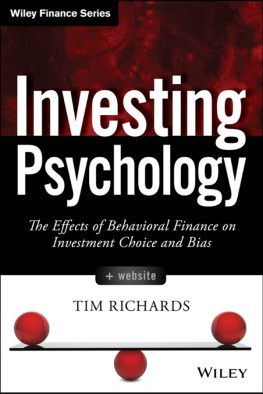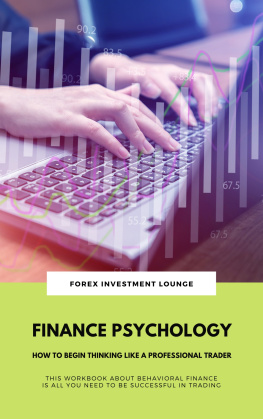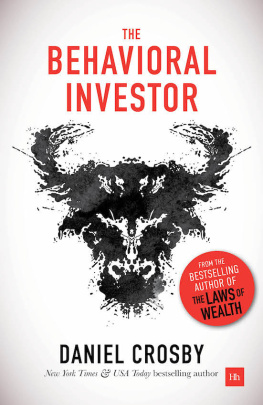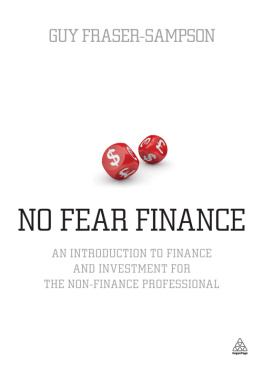
The Wiley Finance series contains books written specifically for finance and investment professionals as well as sophisticated individual investors and their financial advisors. Book topics range from portfolio management to e-commerce, risk management, financial engineering, valuation and financial instrument analysis, as well as much more. For a list of available titles, visit our Web site at www.WileyFinance.com.
Founded in 1807, John Wiley & Sons is the oldest independent publishing company in the United States. With offices in North America, Europe, Australia and Asia, Wiley is globally committed to developing and marketing print and electronic products and services for our customers' professional and personal knowledge and understanding.
Investing Psychology
The Effects of Behavioral Finance on Investment Choice and Bias
TIM RICHARDS
Creator of the Psy-Fi Blog (www.psyfitec.com)
Cover image: iStochphoto.com/AmandaRuch iStochphoto.com/fatido
Cover design: Wiley
Copyright 2014 by Tim Richards. All rights reserved.
Published by John Wiley & Sons, Inc., Hoboken, New Jersey.
Published simultaneously in Canada.
No part of this publication may be reproduced, stored in a retrieval system, or transmitted in any form or by any means, electronic, mechanical, photocopying, recording, scanning, or otherwise, except as permitted under Section 107 or 108 of the 1976 United States Copyright Act, without either the prior written permission of the Publisher, or authorization through payment of the appropriate per-copy fee to the Copyright Clearance Center, Inc., 222 Rosewood Drive, Danvers, MA 01923, (978) 750-8400, fax (978) 646-8600, or on the Web at www.copyright.com. Requests to the Publisher for permission should be addressed to the Permissions Department, John Wiley & Sons, Inc., 111 River Street, Hoboken, NJ 07030, (201) 748-6011, fax (201) 748-6008, or online at www.wiley.com/go/permissions.
Limit of Liability/Disclaimer of Warranty: While the publisher and author have used their best efforts in preparing this book, they make no representations or warranties with respect to the accuracy or completeness of the contents of this book and specifically disclaim any implied warranties of merchantability or fitness for a particular purpose. No warranty may be created or extended by sales representatives or written sales materials. The advice and strategies contained herein may not be suitable for your situation. You should consult with a professional where appropriate. Neither the publisher nor author shall be liable for any loss of profit or any other commercial damages, including but not limited to special, incidental, consequential, or other damages.
For general information on our other products and services or for technical support, please contact our Customer Care Department within the United States at (800) 762-2974, outside the United States at (317) 572-3993 or fax (317) 572-4002.
Wiley publishes in a variety of print and electronic formats and by print-on-demand. Some material included with standard print versions of this book may not be included in e-books or in print-on-demand. If this book refers to media such as a CD or DVD that is not included in the version you purchased, you may download this material at http://booksupport.wiley.com. For more information about Wiley products, visit www.wiley.com.
Library of Congress Cataloging-in-Publication Data:
Richards, Tim, 1961
Investing psychology : the effects of behavioral finance on investment choice and bias / Tim Richards.
pages cm.(Wiley finance series)
Includes bibliographical references and index.
ISBN 978-1-118-72219-0 (cloth)
1. InvestmentsPsychological aspects. 2. FinancePsychological aspects. I. Title.
HG4515.15.R53 2014
332.6019dc23
2013050096
To Skyla, Alexa, and Hallie;
for being there always,
as I will always be here for you.
Preface
As we move forward through the twenty-first century, it's more and more important for investors to understand the unconscious drivers that affect the way they make decisions about money because increasingly we're being left to fend for ourselves. It wasn't so long ago that retirees could look forward to a comfortable old age supported by employee sponsored, defined benefit pension plans and a generous social security system. Those days have gone, and more often than not we're being left to make our own investing decisions using 401(k) plans and other individually managed accounts.
At the same time, a vast expansion of the financial services industry has put us in charge of many more financial decisionsno longer are we limited in how much we can borrow by a wise old bank manager, but we are left to decide how much we can repayand we must take the consequences when these decisions go wrong. This is especially so as a huge industry has grown up to exploit our biases, in order to part us from our money. The securities industry is a gigantic machine for extracting money from ordinary investors, and does so in a way that makes it all seem perfectly reasonable.
All this is happening as lifespans are lengthening due to improvements in medical care and a better understanding of healthy living. So the decisions we make about our money will determine whether our lengthening old ages are played out in comfort or misery. Learning how, and why, we make these decisions, and how we can improve them, should be a priority for all of us.
Although we've been given greater freedom of choice than ever before, we've not been granted any greater wisdom, or given any training about how to proceed. That's what this book is about, how to use the opportunity we've been given, how to avoid the traps set by our own minds and by those people who want to exploit them. It's a fascinating journey and one, I believe, that will leave you with a permanent advantage over those who don't choose to join us.
Although this is a book with a serious purpose, and is full of carefully chosen academic research to illustrate the points that I want to make, it is not, I hope, a seriously difficult read. Writing an important book that no one reads because it's too difficult and clever would be missing the point: unless this material is accessible to investors and their advisers, it can't help them. Equally, though, I'd urge you not to be fooled by the often light-hearted tonethis is a book with a very serious purposeto help us figure out how to overcome the enemy within, our own brains. Because if we can't, then we will end up being seriously impoverished.
The book is divided into nine chapters, the first four of which deal with particular aspects of the behavioral flaws that drive us to throw our money at people who are already rich. This is a whistle-stop tour of dozens of different types of behavioral biases, which intends to kick away any illusions you have about yourself and your investing abilities and trample them into the dust.
We start by looking at how our senses often fool us into thinking that there are things going on out there, when they're actually only going on in our heads. Our brains are attuned to the world around us, and they function in a way that gives us the best chance of survival; but these behaviors are often not appropriate when we're investing. Believing that we can influence or even predict markets in a desperate attempt to keep our brains happy is a one-way ticket to penury.
Next page











![Tim Richards [Tim Richards] - Investing Psychology: The Effects of Behavioral Finance on Investment Choice and Bias, + Website](/uploads/posts/book/124122/thumbs/tim-richards-tim-richards-investing-psychology.jpg)
![Daniel Crosby [Daniel Crosby] - The Laws of Wealth: Psychology and the secret to investing success](/uploads/posts/book/124058/thumbs/daniel-crosby-daniel-crosby-the-laws-of-wealth.jpg)

